One of my very first garden plants when I was a young boy was Pulmonaria rubra, a very easy and dependable spring bloomer. This species is considered somewhat leafy and coarse, with simple hairy green leaves without the white mottling and speckling touted by the modern hybrids, but I still like it Here are some photos showing plants colonizing the driest of dry woods (under Sugar maples) down at the uncultivated bottom of my yard and woodland where hoses don't reach. The photos show plants in full flower with salmon-red blooms that age blue, the forest floor still strewn with fallen branches from the great ice storm of 2008. The plants shown are from my original stock when I was 10 years old, over 45 years ago! :o :o :o
I googled and found some interesting information on the genus Pulmonaria, Plant Delights Nursery pays homage to Pulmonaria with a separate web domain with useful information on the genus, the page called "Pulmonaria, Pulmonaria, Pulmonaria - The World of Lungworts":
http://www.pulmonarialungwort.com/
A couple of selections from Plant Delights Nursery:
Pulmonaria 'Dark Vader' (looks somewhat similar to P. rubra, which is obviously one of the parents)
http://www.plantdelights.com/Catalog/Current/Detail/04346.html
Pulmonaria 'Silver Bouquet'
http://www.plantdelights.com/Catalog/Current/Detail/08623.html
Take a look at this one, has P. longifolia v. cevennensis in its parentage.
Also found this page:
Pulmonaria in Flora Italiana
http://luirig.altervista.org/flora/pulmonaria.htm
Comments
Re: Pulmonaria - useful spring Lungworts!
The genus Pulmonaria is one of the more common plant groups here. P. rubra grows wild (garden escapee) in the deciduous woods here and so do other species and hybrids. I have a lot of cultivars but like you Mark let them self-seed. Some of the blue types are fine (no flowers yet).
Re: Pulmonaria - useful spring Lungworts!
As requested, Pulmonaria altaica, an introduction from Siberia by Josef Halda, according to Wrightman's, source of my plant in 2008:
http://www.wrightmanalpines.com/details.asp?PRODUCT_ID=P077
It is quite lovely - the leaves are finely felted and soft as a (black) lab's* ears, and the flowers are quite large.
(*Oh okay, I understand that the golden lab lobby is demanding equal ear-fondling time!)
Re: Pulmonaria - useful spring Lungworts!
Got P. altaica on order!
Re: Pulmonaria - useful spring Lungworts!
My first Pulmonaria are open...Pulmonaria rubra and Pulmonaria longifolia. Pulmonaria angustifolia is open too but I have not had a chance to get a picture yet. These pictures are taken with my new NikonD300S
Re: Pulmonaria - useful spring Lungworts!
Pulmonaria 'Baby Blue'
Color really is a light baby blue, and plant is only a foot wide.
Re: Pulmonaria - useful spring Lungworts!
Pulmonaria 'Baby Blue'
Color really is a light baby blue, and plant is only a foot wide.
That's a good one Rick, I'm a sucker for light blue, I'll have to be on the lookout for this one. The 'Baby Blue' cultivar looks somewhat similar to one I grow called 'Roy Davison', which is smaller than many, staying fairly low, with light blue flowers, with noticeably pointed leaves, and sometimes with cauline stem leaves almost entirely white.
Re: Pulmonaria - useful spring Lungworts!
It's been a whole month since we started posting photos of Pulmonarias in flower, and they are going as strong or stronger than ever, really becoming a backbone of flower and foliage color for the spring woodland garden. Lots of seedling babies are showing up, now is the time to put them where wanted, before they get too big in the wrong spot.
1-2 Pulmonaria self-sown plants, providing nice blue backdrop to other spring flowering woodlanders.
3 Tiarella 'Stargazer Mercury' with Pulmonaria backdrop.
4-5 P. 'Roy Davidson' - I had forgotten how this cultivar does reach taller, it's very small pale blue flowers less effective, but the narrow angular spotted foliage define the cultivar.
6 Self-sown seedling, with good blue flowers and extra good white leaf mottling.
7 taken in a friends garden, they believed this to be Pulmonaria longifolia ssp. cevennensis, certainly a good deep blue and with distinctive extra long and narrow foliage.
Re: Pulmonaria - useful spring Lungworts!
A very nice Tiarella, and nice A. sikokianum, I think, in the background of that pic.
Re: Pulmonaria - useful spring Lungworts!
All of them are nice! I have quite a few Pulmonarias myself and I let them grow where they germinate except a few places.
Mark, what kind of plant in your first photo, to the left, with star-shaped red-marked leaves; and does the small white flowers belong to the leaves?
Re: Pulmonaria - useful spring Lungworts!
All of them are nice! I have quite a few Pulmonarias myself and I let them grow where they germinate except a few places.
Mark, what kind of plant in your first photo, to the left, with star-shaped red-marked leaves; and does the small white flowers belong to the leaves?
Trond, that is one of the newer hybrid foamflowers, Tiarella 'Stargazer Mercury'... or at least it should or might be that cultivar... they tend to die out, seedlings arise or the plant moves around, and I'm not 100% sure of its name at this point, even though that's what a nearby label says. As you're probably aware, there has been an explosion of new Tiarella and Heucherella hybrids in the past decade, all kinds of fancy leaf types. I have tried about 10 of them, but I believe these newer cultivars have not been properly tested, almost all of the die back and fade out over a few years, whereas the species T. cordifolia and wherryi, were always completely reliable plants when I grew them years ago, making large showy patches. These new cultivars just sort of "fall apart" in a couple years, leaving weak bits of growth behind; I'm getting fed up with these overbred and insufficiently tested (and expensive) hybrids. Only 2 of those 10 that I've tried seem reliable, this is one of them.
Re: Pulmonaria - useful spring Lungworts!
All of them are nice! I have quite a few Pulmonarias myself and I let them grow where they germinate except a few places.
Mark, what kind of plant in your first photo, to the left, with star-shaped red-marked leaves; and does the small white flowers belong to the leaves?
Trond, that is one of the newer hybrid foamflowers, Tiarella 'Stargazer Mercury'... or at least it should or might be that cultivar... they tend to die out, seedlings arise or the plant moves around, and I'm not 100% sure of its name at this point, even though that's what a nearby label says. As you're probably aware, there has been an explosion of new Tiarella and Heucherella hybrids in the past decade, all kinds of fancy leaf types. I have tried about 10 of them, but I believe these newer cultivars have not been properly tested, almost all of the die back and fade out over a few years, whereas the species T. cordifolia and wherryi, were always completely reliable plants when I grew them years ago, making large showy patches. These new cultivars just sort of "fall apart" in a couple years, leaving weak bits of growth behind; I'm getting fed up with these overbred and insufficiently tested (and expensive) hybrids. Only 2 of those 10 that I've tried seem reliable, this is one of them.
Thank you, Mark. I thought it was something familiar but I couldn't place it. I have not grown any of the new hybrids but the old species and they make good display when in flower. If I come across 'Stargazer Mercury' I think I will give it a try.
Re: Pulmonaria - useful spring Lungworts!
Meant to post these photos sooner, but I was wondering if others experience mildew problems soon after the plants flower. These things bloom for a full 4-6 weeks, but upon finishing, I find that the blue-flowered hybrids go 100% mildewy on the leaves, stems, and spent inflorescences, looking mighty unsightly for weeks that follow. By about mid-June, some leaves will have survived the onslaught, most other mildewed leaves having collapsed and mostly dried up... much of the debris can be cleaned up at that time if desired. Yet the plants go on, and for the many years I have watched this phenomenon, the plants continue to grow and prosper each year in spite of this mildew cycle. Young seedlings also show up here and there, from last year's dropped seed, which I either weed out or move to spots where I want them to be. On the links I posted earlier, there is mention that hybrids involving certain species (such as Pulmonaria officinalis) are very prone to mildew.
Re: Pulmonaria - useful spring Lungworts!
I have never observed mildew on my plants although annual/biennial Myosotis species get it sometimes.
Re: Pulmonaria - useful spring Lungworts!
No mildews here, either.
Re: Pulmonaria - useful spring Lungworts!
I've never observed mildew on any of the Pulmonarias in my garden or at Denver Botanic Gardens, and we have quite a few...we dod get mildew on columbines, phlox and quite a few other things, usually in later summer when we have more rains...
Re: Pulmonaria - useful spring Lungworts!
Very interesting... !
I do get mildew on a couple of lungworts here, likely due to drought stress (or so I have assumed ???). The ones that get it every year are Pulmonaria saccharata 'Doris Bielefeld', and 'Majeste'. Others seem to be immune - Pulmonaria longifolia 'E. B. Anderson', P. vallarsae 'Margery Fish', P. rubra, 'Baby Blue', 'Excalibur', 'Little Star', P. altaica, 'Apple Frost, 'Trevi Fountain'...
Does anyone detect a pattern there?
Re: Pulmonaria - useful spring Lungworts!
Very interesting... !
I do get mildew on a couple of lungworts here, likely due to drought stress (or so I assume). The ones that get it every year are Pulmonaria saccharata 'Doris Bielefeld', and 'Majeste'. Others seem to be immune - Pulmonaria longifolia 'E. B. Anderson', P. vallarsae 'Margery Fish', P. rubra, 'Baby Blue', 'Excalibur', 'Little Star', P. altaica, 'Apple Frost, 'Trevi Fountain'...
Lori, I never heard of some of those cultivars! I must be living under a rock ;D Useful information to get this sort of feedback, as to which Pulmonaria varieties might be more resistant to mildew.
In my initial posting where I give the link to Plant Delights Nursery page on Pulmonaria, it cites early cultivars involving Pulmonaria officinalis as being particularly prone to mildew... maybe that's the background of the unnamed "blues" I have. My P. 'Roy Davidson' also suffers from the mildew attacks, maybe catching it from the others. But they all recover, and still seem to increase and become mild "seeders" which needs to be watched. Plants of P. rubra do not show any mildew problem here.
Re: Pulmonaria - useful spring Lungworts!
As a follow up to this thread, a reminder that Pulmonarias can be useful later in the season too. I described how after flowering, many of the forms and cultivars I have get terribly mildewed and eventually shed most of the leaves... weeks of seeing ugly distorted browning leaves. Then the leaves grow out again, and on most of them, look as fresh as they did in spring! Here's an unnamed seedling (the named cultivars seed around into a soup of variants and hybrids), looking rather good, the milk-splattered foliage has welcome visual impact now in the woodland garden, where there isn't much color otherwise.
Re: Pulmonaria - useful spring Lungworts!
Yes, indeed - a very useful and decorative group for later in the season. They are not so prone to mildew in my yard, as I mentioned, but cutting away the old flower stems helps to neaten them up, after the spring flush of bloom.
1) Pulmonaria 'Excalibur'
2, 3) And a couple of random seedlings
Re: Pulmonaria - useful spring Lungworts!
Re. our earlier chat on mildew resistance, from an old plant tag....
"Pulmonaria 'Excalibur' (Terra Nova Nurseries)... mildew-resistant as are all selected P. vallarsae crosses..."
I'm not sure if this is implying that P. vallarsae is mildew-resistant, or that they are carefully selecting crosses that are, from a population that generally isn't... ?
Re: Pulmonaria - useful spring Lungworts!
Maybe I should re-title this topic, to something like "useful spring and late summer Lungworts" because here in New England, they go through a rather alarming and remarkable cycle. Of course in spring they are highly ornamental both for foliage and flower, but in early summer they go through a terrible phase of severe mildew, looking horrible, like something that should be tossed in the trash bin, but remarkably recovering later in the summer, making gorgeous clumps of foliage.
Most all of mine are self-sown hybrids, the named ones long since replaced by seedling progeny. So now I don't pay much attention to the named cultivars, instead enjoying the variety of self-sown seedling plants.
Left: one with so many white splotches that it looks almost entirely silver white in the garden.
Center: one with big white spots on the left, and a greener leafed plant on the right with smaller white spots.
Right: two plants with bold white splotches, the one on the right with decidely bigger white patches.
A couple garden scenes showing just how visually attractive these Pulmonarias are in the ragged late summer season garden, after an exceptionally hot summer, and alternating periods of drought and heat, followed by daily monsoon rains and steam heat, and repeat the pattern. Any plant that can come through such a challenging summer is worthy of attention. These seed around a bit too easily, so I have to keep them in check, but it's beneficial to have such self sowing, I can always save the few that I want, and weed out the others.
Left: general garden scene showing the Pulmonarias in a mixed woodland planting, Cypripedium parviflorum var. pubescens in the center with drying reddish-brown leaf tips actually still looks attractive in leaf.
Right: same scene but from a more distant vantage point, showing a selected Epimedium hybrid that has red leaves all summer, particularly red in late summer and fall.
Re: Pulmonaria - useful spring Lungworts!
It's amazing how plants bounce back from the challenging conditions in your area, Mark! Aside from the gorgeous pulmonarias, that red epimedium hybrid is stunning too! There is another plant in your photos that looks fabulous also - what's the red-tipped plant with the linear(poor description) veins?
Pulmonaria is a very useful genus here too... the plants mostly only have to withstand dry conditions and wilting (with some then being affected by mildew), aside from getting pummelled by hail.
This plant (with some similar seedlings below it) is a good, mildew-resistant one that has been looking great all summer - Pulmonaria vallarsae 'Marjerie Fish'; (these are alongside the cat pen, where our cats can disport themselves in the fresh air and sunshine without either getting run over by Buicks or being able to exercise their avicidal tendencies ;)):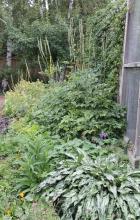
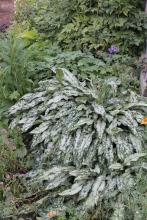
Various seedlings on the edge of what we have been euphemistically refering to as the "vegetable garden"... (a spur of the moment thing... not surprisingly, from a July planting, only radishes and spinach have produced yields :rolleyes:):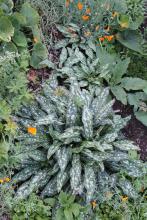
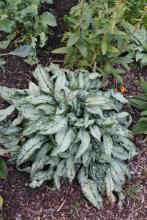
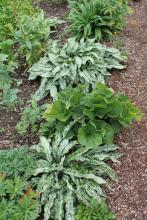
The one in the middle picture above is looking rather 'Excalibur'-like... presumably the influence of two 'Excalibur' specimens along the side of the house, one of which is shown below (another excellent mildew-resistant one):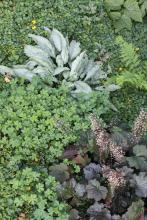
Re: Pulmonaria - useful spring Lungworts!
My goodness Lori, you have some near white-leaved Pulmonaria plants, outstanding! The "red-tipped plant with the linear veins" is Cypripedium parviflorum var. pubescens. Hopefully NARGS forumists will see that Pulmonarias are awesome plants for the hardy shade garden, withstanding adverse conditions and always pulling through.
Re: Pulmonaria - useful spring Lungworts!
Both of you Lori and Mark, really do have some very nice specimens of Pulmonaria :o
Till now I have been more interested in the spring flowering display than the leaves. My plants disappear among stronger growing neighbours in summer.
Re: Pulmonaria - useful spring Lungworts!
Mark - I have always thought of woodland plantings being as delightful in spring for the tapestry of foliage as flowers. By now many of the plants in shade in our garden have died back, but things like pulmonarias and hellebores still look really good. Your pictures though look as good as any spring planting and show how really valuable these plants are; I must work harder to get the same effect under the apples where I am steadily growing more and more woodlanders. Would love to succeed with cypripediums but have always thought them to be pretty specialised in what they need.
Re: Pulmonaria - useful spring Lungworts!
Great looking plants! I haven't seen any locally, but I don't often get to the real garden centres, just occasionally check out the big box offerings.. Something to watch for.. Some of the lance-leaf types Lori shows are especially nice!

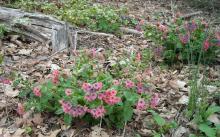
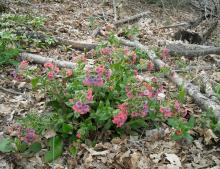
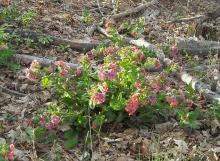
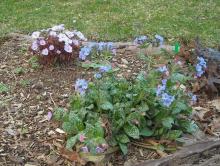
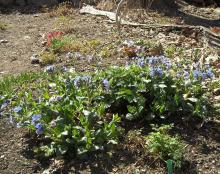

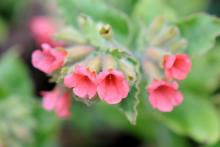
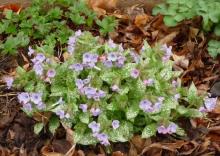
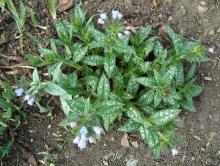
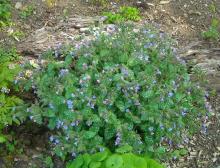
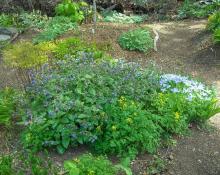
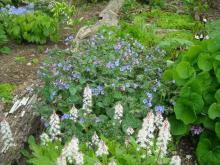
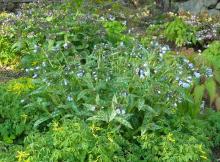
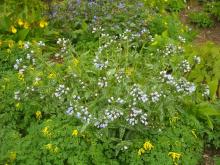
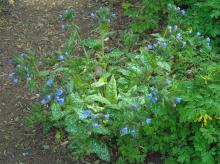
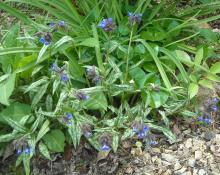
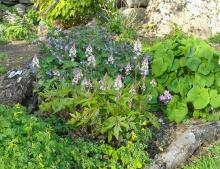
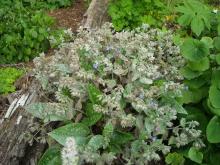
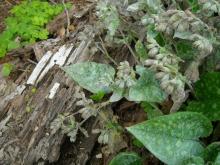
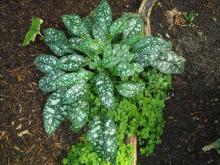
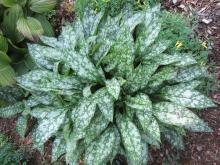
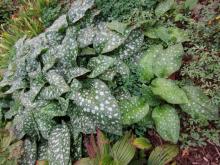
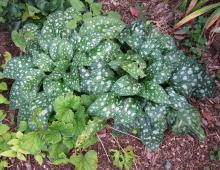
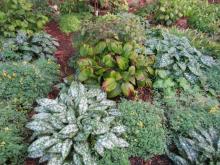
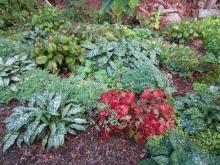

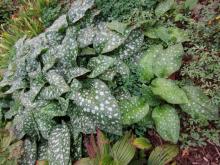

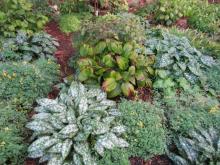
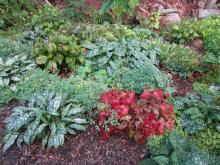






There are lots and lots of Pulmonaria cultivars available. My experience with them is that they don't always last and can die out after a couple years, but they leave hybrid seedlings behind, which vary and can't bear the cultivar names. I don't bother with most of the named cultivars these days, I just let the variable hybrid seedlings spread around, satisfied to have some very nice blue-flowered plants in spring. In summer, they often suffer from mildew blight on the foliage making them look ratty, but it doesn't seem to hurt them in the long run, and they always come back each spring, as well as spread by self-sown seedlings. Here are a couple such no-name blue lungworts.